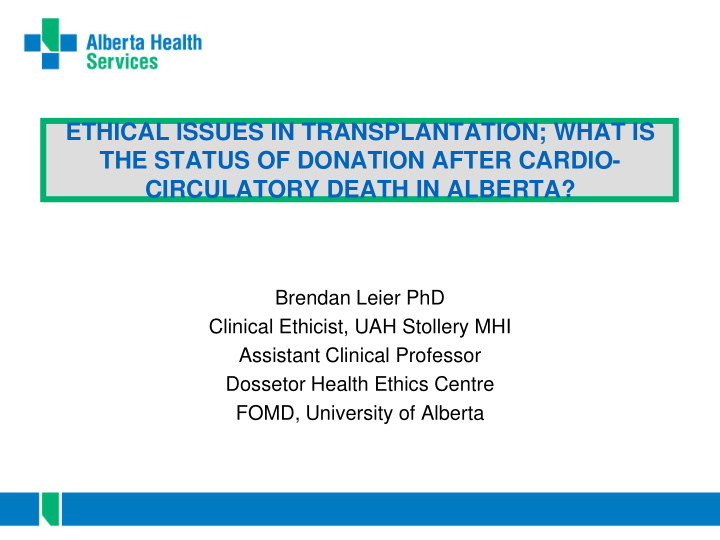



ETHICAL ISSUES IN TRANSPLANTATION; WHAT IS THE STATUS OF DONATION AFTER CARDIO- CIRCULATORY DEATH IN ALBERTA? Brendan Leier PhD Clinical Ethicist, UAH Stollery MHI Assistant Clinical Professor Dossetor Health Ethics Centre FOMD, University of Alberta
A Very Quick Overview… 2
A Very Quick Overview… • Types of transplant – Living donor (LR, LUR) – Cadaveric • NDD (brain dead) • DCD (cardio-circulatory death) 3
Harvard Ad Hoc Committee 1968 A definition of irreversible coma: report of the Ad Hoc Committee of the Harvard Medical School to Examine the Definition of Brain Death. JAMA 1968;205:337-40. 4
A Very Quick Overview… • 1950: First successful kidney transplant by Dr. Richard H. Lawler (Chicago, U.S.A.) [13] • 1954: First living related kidney transplant (identical twins) (U.S.A.) [14] • 1955: First heart valve allograft into descending aorta (Canada) • 1962: First kidney transplant from a deceased donor (U.S.A.) 5
A Very Quick Overview… • 1965: Australia's first successful (living) kidney transplant (Queen Elizabeth Hospital, SA, Australia) • 1966: First successful pancreas transplant by Richard Lillehei and William Kelly (Minnesota, U.S.A.) • 1967: First successful liver transplant by Thomas Starzl (Denver, U.S.A.) • 1967: First successful heart transplant by Christian Barnard (Cape Town, South Africa) • 1981: First successful heart/lung transplant by Bruce Reitz (Stanford, U.S.A.) 6
Maastricht classification Cate Type Circumstances Typical location gory 1 Uncontrolled Dead on arrival Emergency Department 2 Uncontrolled Unsuccessful Emergency resuscitation Department 3 Controlled Cardiac arrest Intensive Care follows planned Unit withdrawal of life sustaining treatments 4 Either Cardiac arrest in a Intensive Care patient who is Unit brain dead 7
Numbers in Canada From 2012 Canadian Institute for Health Information NDD - 1230 DCD - 164 LR - 325 LUR - 134 LDPE - 25 8
Numbers in Canada From 2012 Canadian Institute for Health Information DCD by province: • Alberta - 3 • BC - 31 • Ontario - 130 9
UAH 10
Ethical Issues • Philosophical Concerns • Practical Concerns 11
Philosophical Concerns • The Dead Donor Rule (is it circular?) 12
Philosophical Concerns • The Dead Donor Rule • Not “really” dead (essentialism problem, irreversibility, etc.) 13
Philosophical Concerns • The Dead Donor Rule • Not “really” dead (essentialism problem, reversibility, etc.) • Conceptual honesty and transparency 14
Philosophical Concerns Two proposed solutions to addressing the philosophical concerns: 1) abandon the dead donor rule. 2) understand the declaration of death correctly as a convention, i.e. the consensus of an expert community for a particular purpose. 15
19 th Century New York Bill • First – Permanent cessation of respiration and circulation. • Second – Purple discoloration of the dependent parts of the body. • Third – Appearance of blistering around a part of the skin touched with a red hot iron. • Fourth – The characteristic stiffness known as rigor mortis. • Fifth – Signs of decomposition 16
Practical Concerns 17
Practical Concerns • conflict of interest (real or perceived) – fiduciary obligation (particularly ICU staff) 18
Practical Concerns • conflict of interest (real or perceived) – fiduciary obligation – process management 19
Practical Concerns • conflict of interest (real or perceived) – fiduciary obligation – process management – perimortem procedures to facilitate transplant (heparin, cannulation, etc.) 20
Practical Concerns • conflict of interest (real or perceived) – fiduciary obligation – process management – perimortem procedures to facilitate transplant (heparin, cannulation, etc.) – conflicts between pts/families in small centres/small pt. populations. 21
Practical Concerns • The devil is in the details 22
Practical Concerns • The devil is in the details • Service with greatest vulnerability must control the process (ICU). 23
Practical Concerns • The devil is in the details • Service with greatest vulnerability must control the process (ICU). • Staff must feel supported both by clear policy and rational regarding process, but also to conscientiously withdraw from the process. The process must be transparent. 24
Some Last Thoughts • Understand transplant as a necessary transitional technology. 25
Some Last Thoughts • Understand transplant as a necessary transitional technology. • Understand the fundamental communal values that make transplant possible, i.e. trust, compassion. 26
Some Last Thoughts • Understand transplant as a necessary transitional technology. • Understand the fundamental communal values that make transplant possible, i.e. trust, compassion. • Identify the unique elements that both define and enable transplant and recognize conventions that serve and are limited by this community. 27
Some Last Thoughts • Understand transplant as a necessary transitional technology. • Understand the fundamental communal values that make transplant possible, i.e. trust, compassion. • Identify the unique elements that both define and enable transplant and recognize conventions that serve and are limited by this community. (pay to play?) • Mitigate the conflict of interest faced by ICU staff by removing the burden of identification/selection of donors and addressing donation at a more appropriate time. 28
Thanks, and please feel free to contact me! Brendan is bleier@ualberta.ca or brendan.leier@albertahealthservices.ca 29
Recommend
More recommend